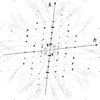issue contents
November 2017 issue

editorial
CHEMISTRY | CRYSTENG
Crystal engineering, which was considered to be crystal structure engineering, is now transforming into crystal property engineering. The same or similar crystal structures could have different properties while different crystal structures could have similar properties.
scientific commentaries
CHEMISTRY | CRYSTENG
Heusler materials have attracted a large amount of attention in the development of spintronic technologies. In this issue, Wang et al. [IUCrJ (2017), 4, 758–768] show how strain can be used to tune the band structure of these materials.
topical reviews
NEUTRON | SYNCHROTRON
Understanding published research results should be through one's own eyes and include the raw diffraction data, an option that has recently become viable at various data archives. Preserving and sharing raw diffraction data will allow challenging data cases in crystallography to be more expeditiously tackled.
research letters
CRYO | EM
The organization of cryo-EM image-processing tools can be tailored for acceleration of the data analysis. Here, this is exemplified by the cryo-EM structure determination of the chlororibosome from spinach leaves to 3.2 Å resolution within 24 h.
PHYSICS | FELS
The temporal coherence of hard X-ray free-electron laser pulses was characterized by capturing single-shot interferograms with a versatile interferometer composed of six separate optical elements. The visibility measurements as a function of time delay revealed a mean coherence time of 5.9 ± 0.7 fs.
CHEMISTRY | CRYSTENG
Hexatungstotellurate(VI) (TEW), an Anderson–Evans-type polyoxometalate (POM), was found to be a promising cocrystallization agent that mediates new strong crystal contacts and contributes significantly to the solvent entropy which presumably leads to a lower free energy of protein crystallization. The results presented herein strongly encourage the use of TEW as a powerful additive in protein crystallization, particularly within or near the liquid–liquid phase separation (LLPS) region.
research papers
PHYSICS | FELS
An algorithm is presented to recover the orientations of nanoparticles with size variations from X-ray free-electron laser (XFEL) scattering.
NEUTRON | SYNCHROTRON
A multiscale in vivo ultrastucture of the Gram-negative bacterium E. coli has been derived using combined small-angle and ultra-small-angle X-ray and contrast-variation small-angle neutron scattering methods.
MATERIALS | COMPUTATION
Under uniform strain, there are natural physical transitions from spin-filter magnetic semiconductor (MS) to spin-gapless semiconductor (SGS) to half-metal (HM) for rare earth-based equiatomic quaternary Heusler (EQH) compounds with the formula LuCoVZ, and from HM → SGS → MS → SGS → HM for EQH compounds with the formula YCoVZ.
BIOLOGY | MEDICINE
The structure of chitotriose bound to lysozyme after mixing times of 2 and 50 s was determined using a polyimide tape-drive device for mix-and-diffuse serial crystallography at a synchrotron light source.
PHYSICS | FELS
Plasma simulations of photon emission spectra from protein crystals in an X-ray free-electron laser pulse show that spectroscopy can be used as a valid hit-detection technique in high-throughput serial femtosecond crystallography experiments.
BIOLOGY | MEDICINE
The complex evolution of diffracted intensities from protein crystals during irradiation by intense Gaussian X-ray microbeams is measured and analysed. The analysis explains non-exponential intensity decays without invoking sequential damage models, yields a revised metric to quantify the damage state of the crystal after a given irradiation time, explains previous observations of a damage `lag' phase and shows how ultra-intense X-ray microbeams allow the data collected per crystal at and near room temperature to be increased.
PHYSICS | FELS
Methods are described for processing XFEL data from individual crystalline fibrils. The methods are applied to data collected at the Linac Coherent Light Source from an amyloid-forming oligopeptide from the adenovirus shaft.
CHEMISTRY | CRYSTENG
Download citation


Download citation


Among the halogen derivatives of salinazid, the chloro and bromo analogues show a mechanical response of jumping and breaking upon heating. Such a thermosalient response is ascribed to the sudden release of accumulated strain during the phase transition and to anisotropy in the cell parameters.



 journal menu
journal menu




 access
access
























